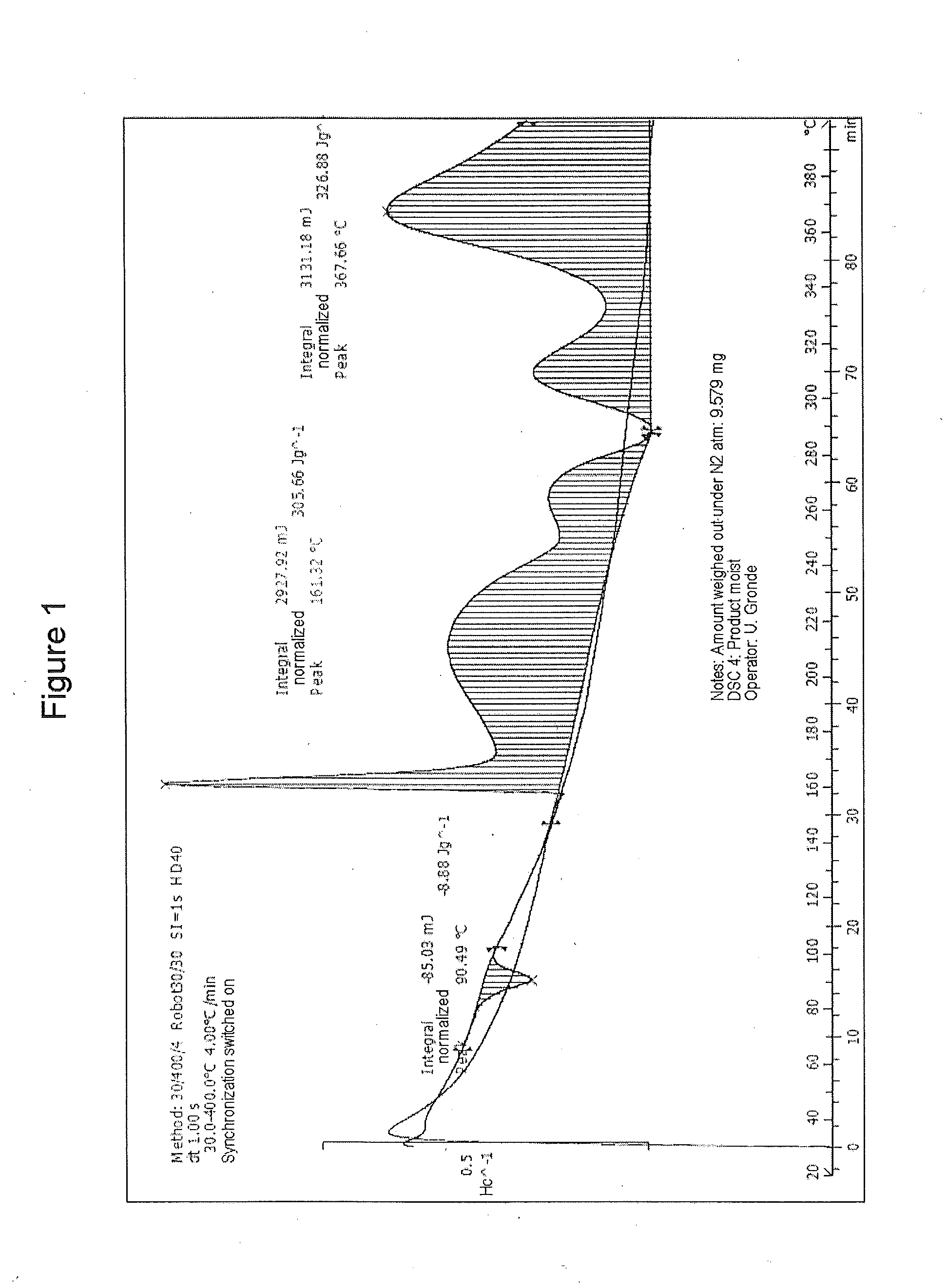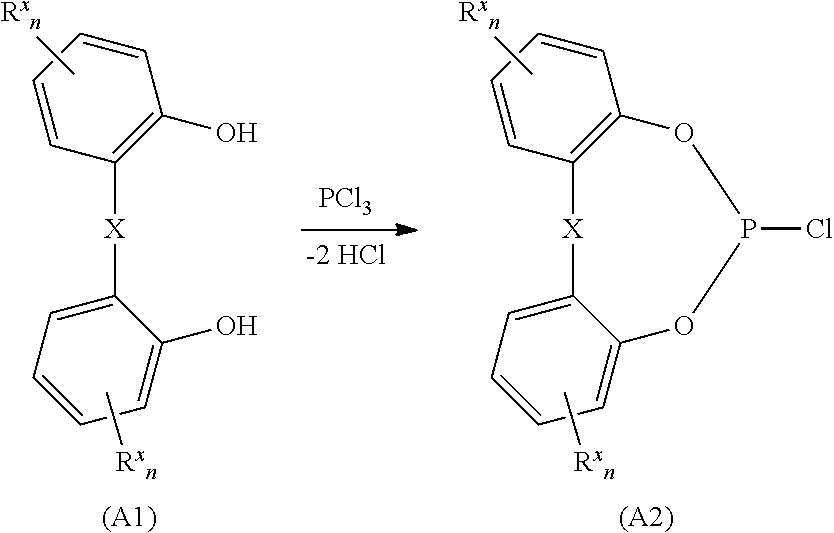Method of purifying organic diphosphite compounds
a diphosphite compound and organic technology, applied in the field of purifying organic diphosphite compounds, can solve the problems of high cost, high cost, and difficulty in removing the acid salts resulting from acid removal,
- Summary
- Abstract
- Description
- Claims
- Application Information
AI Technical Summary
Benefits of technology
Problems solved by technology
Method used
Image
Examples
example 1
Synthesis of 6-chlorodibenzo[d,f][1,3,2]dioxaphosphepin using methylimidazolium hydrochloride as catalyst
[0249]2,2′-Dihydroxybiphenyl (931.1 g, 5.0 mol) and 1-methylimidazolium hydrochloride (0.9 g, 7.6 mmol) were placed under nitrogen in a 2000 ml double-walled reactor and, after melting of the 2,2′-dihydroxybiphenyl, heated to an internal temperature of 142° C. The introduction of phosphorus trichloride (861.2 g, 6.26 mol) was then commenced while stirring, with it being ensured that the phosphorus trichloride did not get onto the hot reactor wall. The rate of introduction was regulated so that the attached HCl scrubbing tower could absorb all of the HCl formed. A total of three hours were required for the addition of the phosphorus trichloride. After the addition of the phosphorus trichloride, the mixture was stirred at 140° C. for another three hours and a fluid yellow reaction mixture was obtained. The reactor was subsequently evacuated over a period of 40 minutes to a final va...
example 2
Synthesis of 6-chlordibenzo[d,f][1,3,2]dioxaphosphepin using N-methylpyrrolidone as catalyst
[0250]A 600 liter vessel provided with inclined-blade stirrer, condenser, offgas discharge facility via a scrubbing tower and a facility for generating vacuum was charged under nitrogen with 2,2′-dihydroxybiphenyl (88.0 kg, 473 mol) and N-methylpyrrolidone (0.337 kg, 3.4 mol). The mixture was melted by heating to an internal temperature of 140° C. and phosphorus trichloride (88.5 kg, 644 mol) was then introduced at 140° C. over a total period of 7 hours. The slightly endothermic reaction proceeded with vigorous HCl evolution and gentle reflux. After all of the phosphorus trichloride had been added, the mixture was stirred at 140° C. for another 9 hours and was then cooled to an internal temperature of the vessel of 50° C. The vessel was subsequently slowly evacuated at 50° C. to a final pressure of 20 mbar (condenser temperature 5° C.) in order to remove the excess phosphorus trichloride. Exc...
example 3
6,6′-[[3,3′,5,5′-Tetrakis(1,1-dimethylethyl)-[1,1′-biphenyl]-2,2′-diyl]bis(oxy)]bisdibenzo[d,f][1,3,2]dioxaphosphepin
[0251]A solution of 3,3′,5,5′-tetra(1,1-dimethylethyl)-1,1′-biphenyl-2,2′-diol (92.7 kg) in a mixture of 1-methylimidazole (40.8 kg) and toluene (313.5 kg) was added to the melt of 6-chlorodibenzo[d,f][1,3,2]dioxaphosphepin (118.4 kg) obtained according to example 2 at 85° C. over a period of 60 minutes while stirring. At the end of the addition, two phases were present and these were stirred at 80° C. for another one hour. The internal temperature was then increased to 90° C., the stirrer was switched off to allow phase separation and the phases were left to separate at 90° C. for 20 minutes. 1-Methylimidazolium hydrochloride (59 kg) was obtained as lower phase and this crystallized out immediately. A 31P-NMR of the upper phase remaining in the vessel confirmed that it was a solution of 6,6′-[[3,3′,5,5′-tetrakis(1,1-dimethylethyl)-[1,1′-biphenyl]-2,2′-diyl]bis(oxy)]b...
PUM
| Property | Measurement | Unit |
|---|---|---|
| Temperature | aaaaa | aaaaa |
| Temperature | aaaaa | aaaaa |
| Purity | aaaaa | aaaaa |
Abstract
Description
Claims
Application Information
 Login to View More
Login to View More - R&D
- Intellectual Property
- Life Sciences
- Materials
- Tech Scout
- Unparalleled Data Quality
- Higher Quality Content
- 60% Fewer Hallucinations
Browse by: Latest US Patents, China's latest patents, Technical Efficacy Thesaurus, Application Domain, Technology Topic, Popular Technical Reports.
© 2025 PatSnap. All rights reserved.Legal|Privacy policy|Modern Slavery Act Transparency Statement|Sitemap|About US| Contact US: help@patsnap.com



